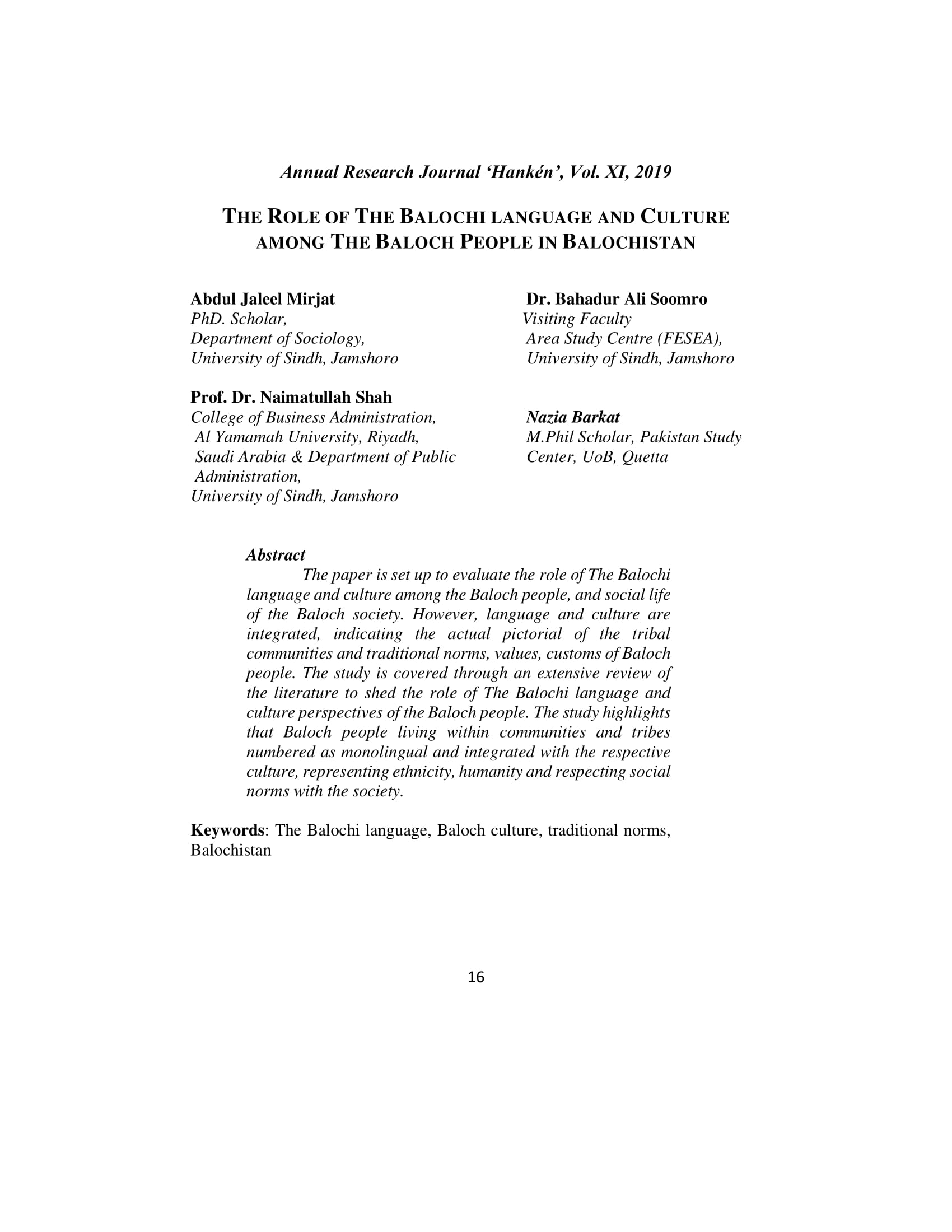THE ROLE OF THE BALOCHI LANGUAGE AND CULTURE AMONG THE BALOCH PEOPLE IN BALOCHISTAN
Keywords:
The Balochi language, Baloch culture, traditional norms, BalochistanAbstract
The paper is set up to evaluate the role of The Balochi
language and culture among the Baloch people, and social life
of the Baloch society. However, language and culture are
integrated, indicating the actual pictorial of the tribal
communities and traditional norms, values, customs of Baloch
people. The study is covered through an extensive review of
the literature to shed the role of The Balochi language and
culture perspectives of the Baloch people. The study highlights
that Baloch people living within communities and tribes
numbered as monolingual and integrated with the respective
culture, representing ethnicity, humanity and respecting social
norms with the society
References
Afghari, A. (2007). A socio-pragmatic study of apology speech act realization
patterns in Persian. Speech Communication, 49, 177-185.
Anzaldua, G. (1987). Borderlands/La Frontera: The new mestiza. San Francisco:
Aunt Lute Book Company.
Baluch, M. S. K. (1977). History of Baluch race and Baluchistan (2nd Ed). Quetta:
Gosha-eAdab.
Bani-Shoraka, H. (2005). The Iranian language policy of the twentieth century. In:
Annika Rabo and Bo Utas (eds.): The Role of the State in West Asia. Istanbul:
Swedish Research Institute. 14:141-50
Blum-kulka, S., House, J. & Kasper, G. (1989). Cross-cultural pragmatics: Requests
and apologies. Ablex, Norwood, NJ.
Chu, J. & Zhu, X. (2010). Culture-oriented evaluation method for interaction:
Applied in Chinese E-commerce website design. Paper presented at the
Computer Science and Information Technology (ICCSIT), 2010 3rd IEEE
International Conference, 1, 1-727.
Daniel, A. O., Oludele, A., Baguma, R. & Weide, T. (2011). Cultural issues and their
relevance in designing usable websites. International Journal of Innovative
Technology and Creative Engineering, 1(2), 20-29.
Delforooz, B. (2010). Discourse Features in Balochi of Sistan. Sweden: Uppsala
University.
Erfani, P. (2012). Azeri morphosyntax: The influence of Persian on a Turkic
language. MA: Simon Fraser University.
Fani, M., Ishaque, M., Shahab, Surraya, S., Masood, N., Hussain, Abid, Q., Nadeem,
M., Sajid, Mehmood, Z. & Ismail, M. (2011). The resurgence of baloch ethnicity
and nationalism in Balochistan. European Journal of Social Sciences, 20, (4),
Felix-Brasdefer, J. C. (2006). Speech act perception in interlanguage pragmatics:
Exploring the minds of foreign language learners. /LAUD paper 652/.
Duisburg/Essen: Linguistic Agency, Universitaet Duisburg-Essen.
Hofstede, G, Hofstede, G. J. & Minkov, M. (2010). Cultures and Organizations:
Software of the Mind. 3rd Edition: McGraw-Hill Education.
Hofstede, G., Hofstede, G. J. & Minkov, M. (1997). Cultures and organizations.
McGraw-Hill New York.
Jahani, C. & Korn, A. (2009). Balochi. The Iranian languages. Ed. G. Windfuhr,
-692. London and New York: Routledge.
Jahani, C. (2005). State control and its impact on language in Balochistan. In:
Annika Rabo and Bo Utas (eds.): The Role of the State in West Asia Istanbul:
Swedish Research Institute. 14, 151-63.
Kang, K & Qian, Y.Y. (2010). Innovative communication in global tourism ecommerce sites-a cultural aspect. Advanced Communication Technology
(ICACT), 2010 The 12th International Conference, IEEE, Phoenix Park, South
Korea, pp. 1440-1444.
Katriel, T. (1986). Dugri speech: Talking straight in Israeli Sabra culture. London:
Cambridge University Press.
Kulyk, V. (2010). Ideologies of language use in post-Soviet Ukrainian media.
International Journal of the Sociology of Language, 79-104.
Leuner, B. (2008). Migra on, mul culturalism and Language Maintenance in
Australia: Polish Migra on to Malbourn in the 1980s. Peter Lang: AG,
Interna_onal Academic Publishers.
Lysaght, R. (2009). Language image in national minority language television idents.
TG4 (Teilifı´snaGaeilge, Ireland) and Whakaata Maori (Maori Television, New
Zealand). EstudiosIrlandeses, 445-57.
Martin, L. (1986). Eskimo words for snow: A case study in the genesis and decay of
an anthropological example. American Anthropologist, 88, 418-423.
Mehrton, A. (2008). An honors thesis: Investigating Iran: A challenge for language
policy. The Australian National University. Australia, Canberra.
Mirvahedi, S. H. (2012). The role of satellite channels in language
shift/maintenance: The case of Tabriz, Iran. Proceedings of FEL XIV, 36-41.
Auckland: Foundation for Endangered Languages.
Niazi, T. (2008). Globalization, resource conflicts and social violence in Asia.
International Journal of Contemporary Sociology, 45(1), 197.
Nielsen, J. (1990). Designing user interfaces for international use. Elsevier,
Amsterdam.
Ogiermann, E. (2009). On apologising in negative and positive politeness cultures.
Amsterdam/Philadelphia: John Benjamins Publishing Company.
Ramahobo, L. N. (2008). Ethnicity and Language: Lessons from Botswana. Open
Space Journal, 2 (3), 1-6.
Sarah, G., Nancy, D., & Melinda, P. (2006). Enhancing women access to markets:
An overview of donor programs and best practices. United State Agency for
International Development.
Schwarz, R. (2003). LD and the English language learner. Retrieved October, 1,
, from http://ldlink.coe.utk.edu/pdf_files/esl_ld.pdf
Sepehri, M. B. (2010). Local radio audiences in Iran: An analysis of Ardebilian
people’s trust and satisfaction with 'Sabalan' Radio”: Broadcast Education
Association. Journal of Radio and Audio Media, 17(2), 236-250.
Sherrington, R. (1975). Television and language skills. London: Oxford University
press.
Smith, A., Dunckley, L., French, T.,Minocha, S. & Chang Y. (2004). A process
model for developing usable cross-cultural websites. Interacting with
computers, 16(1), 63-69.
Sohaib, O. & Kang, K. (2014). Cultural aspects of business-to-consumer (B2C) Ecommerce: A comparative analysis of Pakistan and Australia. The Electronic
Journal of Information Systems in Developing Countries, 61 (2), 1-18.
Spooner, B. (2012). Balochi: Towards a biography of the language. In H. Schiffman
(Ed.), Language Policy and Language Conflict in Afghanistan and Its
Neighbors: The Changing Politics of Language Choice (pp. 319-336). Leiden,
Boston: Brill.
Starks, D., Taumoefolou, M., Bell, A., & Davis, K. (2005). Language as a marker
of ethnic identity in New Zealand's Pasifika Communies. Retrieved November
, 2018, from www.lingref.com/isb/4/171ISB4.PDF
Wylie, J. (2004). Translating culture-bound terms in viticultural texts from French
into English: A practical approach. In Cashier (11.1.2005, pp. 4-22). Available
at http://www.afls.net/Cahiers/rentelarticlecorrected25Oct2005/viticultural
evised1


